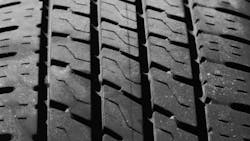If I had a quarter for every phone call that started with the words, “My customer got a ticket for…,” I would have a whole bunch of quarters. There seems to be some varying interpretations of the federal regulations on truck tire and wheel inspection, so I thought it was time to dedicate this month’s column to help clear up some of the confusion. One area that seems to surface quite often is minimum tread depth.
FMCSA regulation
According to Federal Motor Carrier Safety Administration (FMCSA) regulations, the minimum tread depth for a steer tire is 4/32 of an inch on every major tread groove. If one spot on one groove is less than 4/32, then a driver will be issued a citation. The thin decoupling groove at the shoulder, however, is not a major groove. It can theoretically be worn away and the tire will remain in compliance as long as the major grooves are 4/32 when measured anywhere on the tire and there are no other conditions that warrant a violation. These same rules apply to drive and trailer tires, but the minimum tread depth is 2/32 of an inch in every major groove. It’s also important to note that the tread depth measurements cannot be taken at the wear indicators or stone ejectors in the grooves.
CVSA's approach
On the other hand, the Commercial Vehicle Safety Alliance (CVSA) has a completely different rule regarding the minimum tread depth on steer tires. According to CVSA, if the tread depth on a steer tire is less than 2/32 of an inch in two adjacent grooves, then the vehicle is placed out of service until the tire is replaced. The tires on all other wheel positions must have a tread depth of at least 1/32 when measured in any two adjacent grooves at three separate locations at least 8 in. apart around the circumference of the tire or the vehicle is placed out of service.
When a vehicle is declared out of service per CVSA, citations under FMCSA are a certainty. The driver will be issued tickets for every violation that is in place and until the out-of-service violations are remedied, the vehicle cannot be moved. So a driver who operates a vehicle with a steer tire that has a tread depth of 3/32 will be ticketed, but the truck will not be placed out of service. Likewise, if drive or trailer tires have a tread depth of at least 1/32 in every major groove or the worn spots are not adjacent, the driver will be issued citations, but the vehicle can remain in service.
Additional concerns
Another issue that surfaces regularly is the number of threads that must extend beyond the body of the wheel nut. I’ve heard everything from one visible thread to three visible threads, but have yet to find it anywhere in writing. Appendix G to Subchapter B outlines the minimum periodic inspection standards for FMCSA and the only applicable regulation refers to “loose, missing, broken, cracked, stripped or otherwise ineffective fasteners.” The general rule in the industry is full thread engagement, but that doesn’t stop overly aggressive vehicle enforcement officials from making their own interpretations of “ineffective fasteners.”
In most cases, there is a distinct difference between a condition that causes a vehicle to fail inspection, resulting in a citation, and an out-of-service condition. Drivers will be ticketed for every condition under FMCSA inspection guidelines, but the vehicle can remain in service as long as CVSA inspection criteria are met. With the new Compliance, Safety, Accountability program in place, drivers should know the difference between the two because the out-of-service conditions result in additional points and higher vehicle maintenance scores.
About the Author
Kevin Rohlwing
Kevin Rohlwing is the SVP of training for the Tire Industry Association. He has more than 40 years of experience in the tire industry and has created programs to help train more than 180,000 technicians.
